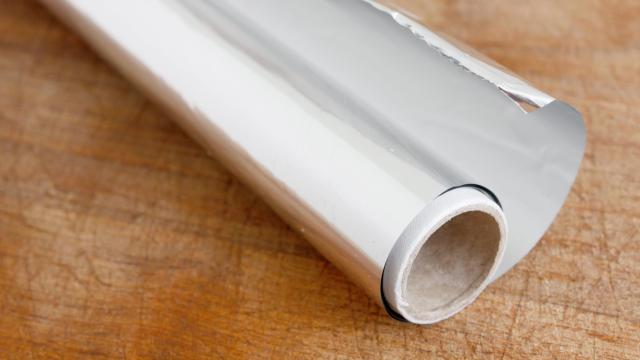We recently posted about the many ways aluminium foil is helpful around the house and quickly found that mentioning “tin foil” was scientifically incorrect (and I’m always willing to admit my mistakes). Depending where you’re from, it might be a natural reflex to say “tin foil” when wrapping up leftovers or cooking on the grill — aluminium foil is a mouthful, and you might not realise there’s a difference. But there is a difference between tin foil and aluminium foil.
What happened to tin foil?
Before 1926, Americans were using foil made of actual tin. The metal sheet was made for industrial use, and it was popular in the early 1900s as packing material and insulation, and used to line cigarette packs. The foil is less durable and more expensive than the aluminium counterpart though, and it’s rare that you’ll find any sort of tin foil these days. When the cheaper aluminium alternative came along, there wasn’t much use for tin foil.
When did aluminium foil take over?
The foil roll in your kitchen is made up of about 99 per cent aluminium alloy, with a dull, silver appearance on one side and shiny one on the other. Basically, in 1910, a Swiss inventor created a continuous rolling process for aluminium, which changed the foil industry. In 1926, Americans started using aluminium foil for packing material in the U.S., and then it became an industry standard.
Still, the new foil didn’t become a household item until a Reynolds staff member was caught in a dilemma on Thanksgiving with nothing to hold the turkey. Thinking quickly on his feet, he grabbed some aluminium foil he had lying around, it worked wonders, and the rest is history.
Can you tell the difference between aluminium and tin foil?
It’s pretty hard to tell them apart, given that tinfoil isn’t widely used anymore. Their appearance is similar enough that most people wouldn’t know unless they were to physically use both to compare. In general, though, tin foil is “less sturdy and stiffer compared to aluminium and can also leave a bitter taste in the food.”
Real tin foil these days is used more for things like electrical capacitors than food prep or storage. It still can be used for packaging materials and such, but since it’s not the popular or cost-effective choice, it’s rare that you’ll find actual tin foil in your local grocery store. More often than not, it’s ok to assume the foil covering your roasted veggies is aluminium.

Leave a Reply
You must be logged in to post a comment.